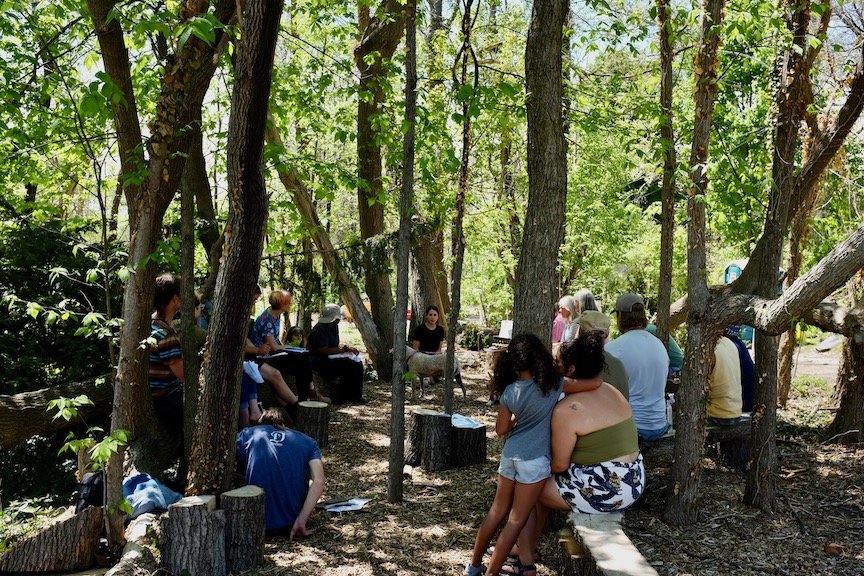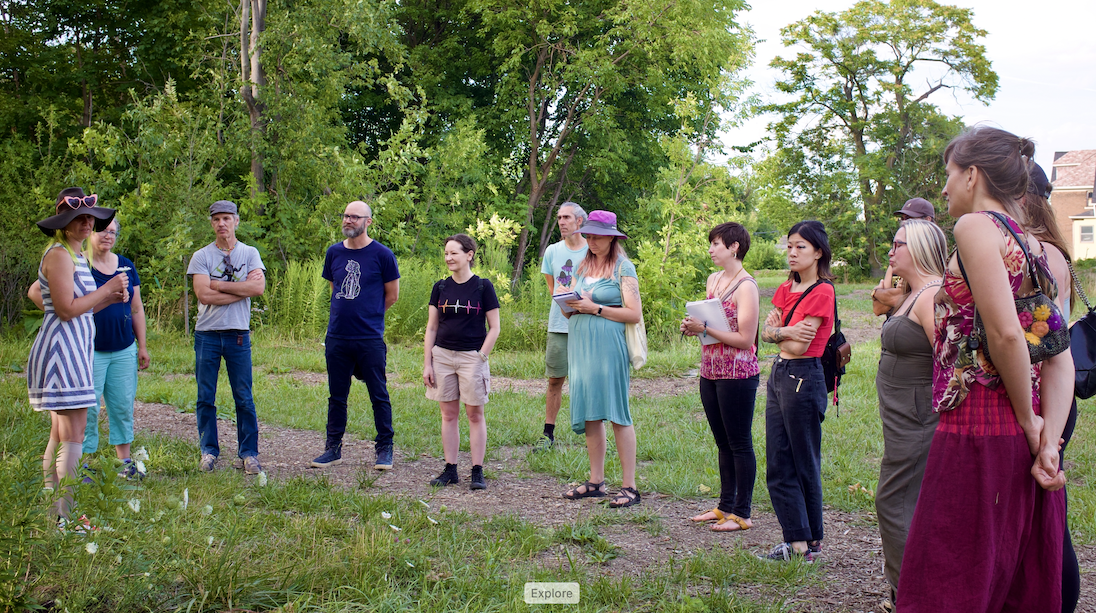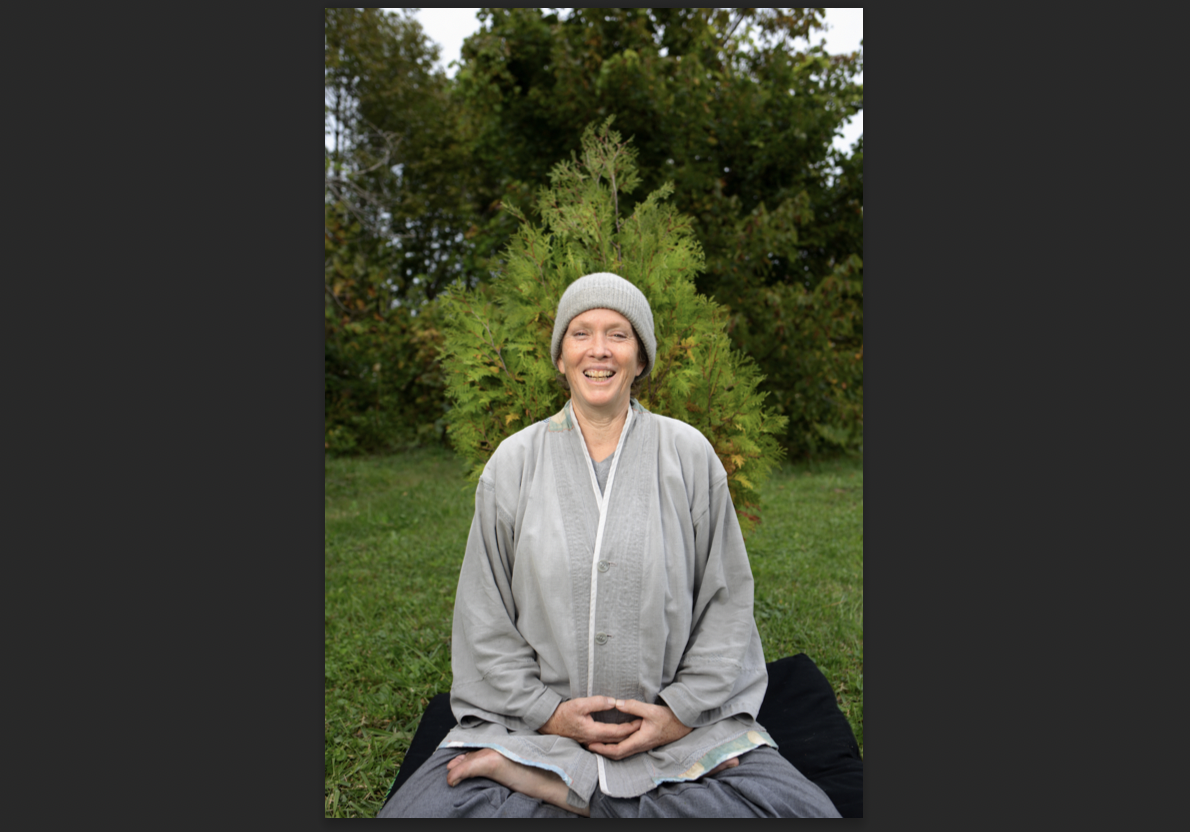We are still in shock and devastated by the natural disaster that demolished our gathering shelter (tree house) in the neighborhood nursery. A massive, hollow Silver Maple with a three foot diameter trunk, came crashing down in the recent storm, and landed precisely in the center of our shelter. It is a blessing and a miracle that nobody was under this roof taking shelter from the rain on this stormy night. Not a single person was hurt, but it does frighten us to think about how there are often a dozen people meeting under this roof for a workday, a meeting, or just hanging out. We are also blessed that it didn’t fall to the East on our neighbor Shawn’s house. This tree would have destroyed whatever was in its path. One understands instantly why many people are afraid of trees. Yes, if they are unhealthy, FKA “dead,” or just planted in the wrong place, they can cause lots of warranted anxiety and danger.
So, on one hand we were lucky it was only the structure and not a person or a home, and not even too many nursery trees. It was a direct hit in the center of the structure’s roof. On the other hand, the arboretum has faced a big setback here, as the structure cost about $3,500 in materials and a year to build with all volunteer labor. What will it take to replace such a gift? We don’t know.
We must admit that for many of us the first reaction was, “oh my God, Wangari!!?!!?!!” Yes, it’s true. This seemingly violent act felt all the more personal because this shelter has become the home of Wangari Maathai, who is depicted in a mural covering an entire wall of the shelter. Brilliant local artist Jozie Bullard has been painting a mural honoring the great Kenyan tree planter and Nobel Laureate for a year. The mural was installed and set to be finished in place the very week of the cataclysm. We are in awe of such force and ask ourselves why. We feel like we are trying to do great things with trees and are shocked when one of our tree friends seems to turn on us. It feels like the wrath of an angry god. So, it is super ironic and cause for lots of reflection. Of course the old tree had no say in this. But who did? That’s kind of how it felt at first. It’s a totally humbling experience to witness such a force of wind, such tonnage of gravity, as well as timing and place.
Guess what, Wangari came through, as of course she would. This woman came through so much adversity, abuse, and disrespect in her life, it’s no surprise that she did not get scratched. This is a small miracle given the chaos of splintering wood that surrounds her. Yes, the three panel mural was broken apart and shattered in places, but the center piece, Wangari herself, stood smiling, reaching out her hands.
Neighborhood kids pulled her from the wreckage the next morning. Bless the neighborhood kids; they probably didn’t know it but they risked their lives to pull this mural out of the wreckage. The heavy roof has been balancing on a scrawny piece of one by that could have snapped at any disturbance. Another small miracle.
Our first thoughts went to Jozie, the artist, wondering what it feels like to see their creation in this sudden state. What follows are some of Jozie’s reflections:
“As I was grieving and reflecting on the reality of the damages, something very spiritual happened to me. For a moment, a calmness came into my mind and body. In this state of being I felt the spirit of Wangari. I could hear her voice faintly whispering within my subconscious saying, “ what happened here in this nursery is the direct effect of climate change and its powerful ability to destroy. She said that the hurt that I felt was real and a similar pain to the one she once felt seeing her homelands in Kenya exploited and distorted due to the continuous effects of colonialism and deforestation. She told me that this violence and harm was the fuel that pushed her to fight to protect the environment and that the tree who crashed down did not do want to do this; this was no natural disaster- this was the physical manifestation and consequence of climate change that continues to poison and destroy the harmony of our home planet earth.
After this realization, I felt clear-headed about what happened. This tragedy is yet another opportunity for embracing change and growing our awareness of the climate crisis. Although saddened by this unfortunate event, I am optimistic for what is to come and blossom through the process of reconstruction and repurposing this commemorative mural honoring the legacy of Wangari Maathai. This accident should not stop us from continuing the quite literal groundbreaking work that the Arb has been uplifting. The work to restore and return natural spaces to the people and help the community widen awareness of our power to impact this vulnerable coexistence we share with the natural world around us.”
Thank you Jozie for all your reflections, your love, and one hundred thousand brush strokes. We can’t wait to see how we all put the pieces back together in new and unforeseen ways. This piece of art just got richer with its history.
There are lessons here. The first lesson is that trees do fall. And that they fall for reasons. And as Jozie points out one of them is man-made climate change / chaos. We need reminders everyday in places like the Midwest where we are largely insulated from the effects of climate change that are ravaging other parts of the world. It is our world and no one is safe until we are all safe.
Second, we understand clearly after a disaster like this why many people are afraid to have a tree near their home. Storms like this down many trees and lots of homes are not spared. We must always consider the right tree for the right place; what kind of tree you are planting and why you are planting it. The tree that fell on the nursery is an old Maple that was planted probably 60-80 years ago. It was on the berm and had been badly beaten up by the heavy artillery of city mowers. This is likely the reason that the tree was so weak and hollowed out from fungus. The wounds inflicted by lawn maintenance crews are the number one cause of tree mortality in cities. Especially when trees are young a weed whip can girdle the tree in one second, cutting off the flow of nutrients and water when the cambium is cut by a whip string. Later in life when the mowers crash into the base of the trunk large wounds are caused that can allow pathogens to enter.
This shelter has been a perfect little meeting place for the neighborhood and an integral part of Arboretum Detroit workdays and operations. Now that we know what it is like to have a central location and meeting place it’s difficult to think about the arb and the neighborhood without it. The reaction of most people to this destruction has been, how do we build something better. When I asked Kevin, the genius carpenter who led the build, what it’s like to see all his work just smashed in a second, he replied, “maybe the trees are just telling us they want a bigger shelter.” Wow. I was amazed and inspired by this positivity and the invitation that followed to help with the rebuild. It will be exciting to watch as both the shelter and the mural are folded into something new, something that contains the force of this moment, a collage of past and future. We all know that it is quintessentially Detroit to build amazing new things from the ashes. It’s our daily challenge here in this city with so much smoke, ash, and aftermath. For Detroiters it’s always just a puzzle.































